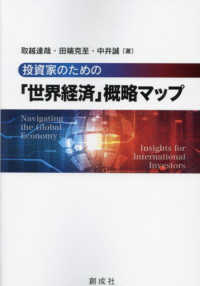- ホーム
- > 洋書
- > ドイツ書
- > Mathematics, Sciences & Technology
- > Physics and Astronomy
- > general surveys & lexicons
Full Description
This book is intended to serve as a basic introduction to scientific computing by treating problems from various areas of physics - mechanics, optics, acoustics, and statistical reasoning in the context of the evaluation of measurements. After working through these examples, students are able to independently work on physical problems that they encounter during their studies. For every exercise, the author introduces the physical problem together with a data structure that serves as an interface to programming in Excel and Python. When a solution is achieved in one application, it can easily be translated into the other one and presumably any other platform for scientific computing. This is possible because the basic techniques of vector and matrix calculation and array broadcasting are also achieved with spreadsheet techniques, and logical queries and for-loops operate on spreadsheets from simple Visual Basic macros. So, starting to learn scientific calculation with Excel, e.g., at High School, is a targeted road to scientific computing. The primary target groups of this book are students with a major or minor subject in physics, who have interest in computational techniques and at the same time want to deepen their knowledge of physics. Math, physics and computer science teachers and Teacher Education students will also find a companion in this book to help them integrate computer techniques into their lessons. Even professional physicists who want to venture into Scientific Computing may appreciate this book.
Contents
1 Introduction: What do you need, what do you learn.- 2 Sets of curves.- 3 Networks of formulas.- 4 Macros.- 5 Basic mathematical techniques.- 6 Superposition of motions.- 7 Random numbers and random number generators.- 8 Evaluation of measurements.- 9 Trend curves.- 10 Integration of Newton's equation of motion.








